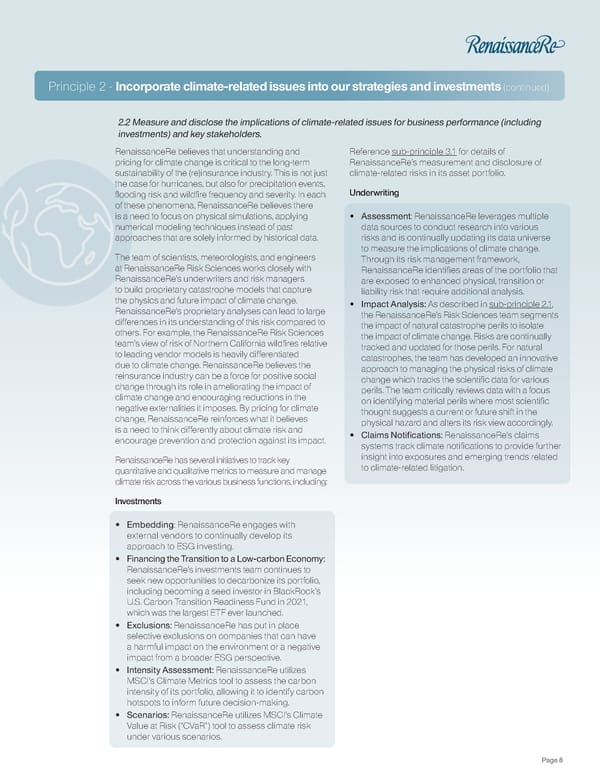Principle 2 - Incorporate climate-related issues into our strategies and investments (continued) 2.2 Measure and disclose the implications of climate-related issues for business performance (including investments) and key stakeholders. RenaissanceRe believes that understanding and Reference sub-principle 3.1 for details of pricing for climate change is critical to the long-term RenaissanceRe’s measurement and disclosure of sustainability of the (re)insurance industry. This is not just climate-related risks in its asset portfolio. the case for hurricanes, but also for precipitation events, Underwriting flooding risk and wildfire frequency and severity. In each of these phenomena, RenaissanceRe believes there is a need to focus on physical simulations, applying • Assessment: RenaissanceRe leverages multiple numerical modeling techniques instead of past data sources to conduct research into various approaches that are solely informed by historical data. risks and is continually updating its data universe to measure the implications of climate change. The team of scientists, meteorologists, and engineers Through its risk management framework, at RenaissanceRe Risk Sciences works closely with RenaissanceRe identifies areas of the portfolio that RenaissanceRe’s underwriters and risk managers are exposed to enhanced physical, transition or to build proprietary catastrophe models that capture liability risk that require additional analysis. the physics and future impact of climate change. • Impact Analysis: As described in sub-principle 2.1, RenaissanceRe’s proprietary analyses can lead to large the RenaissanceRe’s Risk Sciences team segments differences in its understanding of this risk compared to the impact of natural catastrophe perils to isolate others. For example, the RenaissanceRe Risk Sciences the impact of climate change. Risks are continually team’s view of risk of Northern California wildfires relative tracked and updated for those perils. For natural to leading vendor models is heavily differentiated catastrophes, the team has developed an innovative due to climate change. RenaissanceRe believes the approach to managing the physical risks of climate reinsurance industry can be a force for positive social change which tracks the scientific data for various change through its role in ameliorating the impact of perils. The team critically reviews data with a focus climate change and encouraging reductions in the on identifying material perils where most scientific negative externalities it imposes. By pricing for climate thought suggests a current or future shift in the change, RenaissanceRe reinforces what it believes physical hazard and alters its risk view accordingly. is a need to think differently about climate risk and • Claims Notifications: RenaissanceRe’s claims encourage prevention and protection against its impact. systems track climate notifications to provide further RenaissanceRe has several initiatives to track key insight into exposures and emerging trends related quantitative and qualitative metrics to measure and manage to climate-related litigation. climate risk across the various business functions, including: Investments • Embedding: RenaissanceRe engages with external vendors to continually develop its approach to ESG investing. • Financing the Transition to a Low-carbon Economy: RenaissanceRe’s investments team continues to seek new opportunities to decarbonize its portfolio, including becoming a seed investor in BlackRock’s U.S. Carbon Transition Readiness Fund in 2021, which was the largest ETF ever launched. • Exclusions: RenaissanceRe has put in place selective exclusions on companies that can have a harmful impact on the environment or a negative impact from a broader ESG perspective. • Intensity Assessment: RenaissanceRe utilizes MSCI’s Climate Metrics tool to assess the carbon intensity of its portfolio, allowing it to identify carbon hotspots to inform future decision-making. • Scenarios: RenaissanceRe utilizes MSCI’s Climate Value at Risk (“CVaR”) tool to assess climate risk under various scenarios. Page 8
 2022 ClimateWise Report Page 9 Page 11
2022 ClimateWise Report Page 9 Page 11